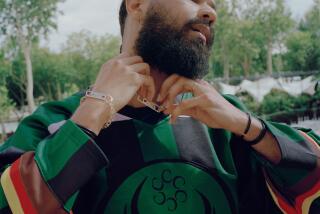Rene Lacoste; Tennis Star, Creator of Sportswear Line
- Share via
PARIS — Rene Lacoste, the French tennis champion of the 1920s who transformed his nickname--”Le Crocodile”--into a status symbol on polo shirts around the world, has died. He was 92.
His daughter, Catherine Lacoste, said her father’s heart failed in his sleep Saturday, four days after surgery on a broken leg. Lacoste had been ailing for years with prostate cancer.
Lacoste was the last survivor of the “Four Musketeers” of French tennis--Lacoste, Henri Cochet, Jean Borotra and Jacques Brugnon. Frenchmen won all six Wimbledon singles titles from 1924 to 1929.
Lacoste was the world’s top player in 1926 and 1927, and won seven major singles titles in his career: Wimbledon twice, the U.S. Open twice and the French Open three times. And, in the victory that may have meant the most to his country, he helped France win the Davis Cup in 1927 by beating Bill Tilden and Bill Johnston. France held the Davis Cup for five more years.
He also perfected the metal-framed, open-throat tennis racket in 1964. And in 1925, lacking partners to improve his smash, he developed one of the first ball-lobbing machines.
But Lacoste is perhaps equally famous for creating the embroidered alligator that has adorned millions of shirts.
His nickname, “Le Crocodile,” apparently came about after he admired a crocodile suitcase in a store window, and his Davis Cup captain promised to buy it for him if he won an important upcoming match. He never got the bag, but U.S. sportswriters took up the name, he said, because it described his style on the court.
“The public must have been fond of this nickname, which conveyed the tenacity I displayed on the tennis courts, never letting go of my prey!” he is quoted as saying on his company’s World Wide Web site. “So my friend Robert George drew an alligator, which I then had embroidered on the blazer I wore on the courts.”
In a 1973 interview with Associated Press, Lacoste was at a loss to explain the popularity of the alligator emblem.
“There are kinds of things that just don’t have any good explanation,” he said. “I suppose you could say that if it had been a really nice animal, something sympathetic, then maybe nothing would have happened. Suppose I had picked a rooster. Well, that’s French, but it doesn’t have the same impact.”
The Paris-born Lacoste did not pick up a tennis racket until he was 16. His playing career ended with a respiratory ailment at age 25, but in the intervening nine years he was recognized as having perhaps the greatest ground stroke in tennis and being one of the game’s most astute tacticians.
Bill Tilden figured it out the hard way. The American champion ran up against Lacoste when he was in his 30s and on the way down.
“This was one of the finest tennis players and tennis brains I ever encountered and I underestimated him,” Tilden said after losing in Davis Cup singles to Lacoste in 1927. “I saw too late that Lacoste had figured out a way to beat me . . . that he had developed a slice serve just for the purpose of using it against me.”
Lacoste’s son, Bernard, took over the sportswear business in 1964 and expanded it into a worldwide operation.
As his tennis career waned, Lacoste turned increasingly to golf. He married Simone Thion de la Chaume, the first French winner of golf’s British Open. They had three sons and a daughter. Catherine Lacoste was a U.S. Open golf champion in 1967.
More to Read
Go beyond the scoreboard
Get the latest on L.A.'s teams in the daily Sports Report newsletter.
You may occasionally receive promotional content from the Los Angeles Times.










